|
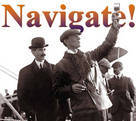
 Up
Up 
 Eyes on
Eyes on
the Skies

(You are here.)



  Need
to Need
to
find your
bearings?
Try
these
navigation aids:
If
this is your first
visit, please stop by:
Something
to share?
Please:



|
|
Available in Française, Español, Português, Deutsch, Россию,
中文,
日本, and others.
|
|
|
 he year 1896 was
eventful for the Wright brothers. It was the centennial anniversary
of the founding of Dayton, Ohio. As descendents of the first
pioneers who settled the town, the Wrights were involved with the
festivities. Orville worked with the Dayton Bicycle Club to build one of the floats
in the centennial parade. It was also the year the Wrights began to
manufacture their own bicycles. They introduced two models, the
economically-priced St. Clair and the top-of-the-line Van
Cleve. Both were named for people who had figured large in
Dayton's early history. he year 1896 was
eventful for the Wright brothers. It was the centennial anniversary
of the founding of Dayton, Ohio. As descendents of the first
pioneers who settled the town, the Wrights were involved with the
festivities. Orville worked with the Dayton Bicycle Club to build one of the floats
in the centennial parade. It was also the year the Wrights began to
manufacture their own bicycles. They introduced two models, the
economically-priced St. Clair and the top-of-the-line Van
Cleve. Both were named for people who had figured large in
Dayton's early history.
Elsewhere in the
world, there was a flurry of aeronautical activity that Wilbur and
Orville could not help but notice. The newspapers were filled
with accounts of experiments with balloons, dirigibles, gliders,
ornithopters (machines
with flapping wings), and airplanes. Most were derisive stories about laughable
failures, but in their midst were three remarkable successes.
|
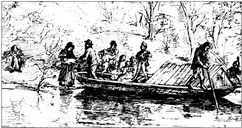
The first party of pioneers to reach Dayton in 1796 included
Catherine B. Van Cleve, the great-great-grandmother of the Wright
brothers. Catherine was the first person to
step off the pirogue onto Dayton's soil, followed by her daughter,
Mary Van Cleve, Wilbur and Orville's great-aunt.
|
The Langley Aerodrome
No one was laughing on 6 May 1896 when
Dr. Samuel Pierpont Langley, Secretary of
the Smithsonian Institution, flew his steam-powered Aerodrome No. 5 half a mile
over the waters of the Potomac River. Langley was an accomplished astronomer
who made the first detailed observations of sun spots, invented the
bolometer to measure electromagnetic radiation, and vastly
simplified the running of the world's railroads by creating
"Standard Time" and time zones. He was also the most well-known
scientist in America due to his campaign of lectures, newspaper
stories, and magazine articles to popularize general science.
In 1886, while he was the director of the Alleghany Observatory,
he became interested in aeronautics after listening to a
presentation on bird flight at a meeting of the American Association
for the Advancement of Science. He built a large "whirling table" to
test wing shapes and began a study of aerodynamics. Before his
experiments could bear much fruit, he was appointed Assistant
Secretary of the Smithsonian Institution in January 1887 and then
Secretary nine months later when his boss died. Langley continued
his aerodynamic experiments at the Smithsonian and built an even
larger whirling table.
Since 1881, when
Louis Mouillard published Empire of the Air, aeronautical
scientists had been divided into two camps -- chauffeurs
whose goal was to create a stable aircraft that could be easily
steered around the sky and pilots who believed that the
equilibrium of the aircraft must be maintained by a skilled
operator. Langley was squarely in the chauffeur camp. He built rubber band-powered airplane models
in hopes of finding a stable configuration. He had no great
success at first, but by 1891 he had developed a model that made
stable flights. That same year he began building a series of larger flying
models that he called "aerodromes" from the ancient greek
aerodromoi which he translated to mean "air-runner." The first,
Aerodrome No. 0, was never completed. Numbers 1, 2, and 3
were completed but never test-flown. Apparently, they did not pass
the aerodynamic tests Langely had devised. In 1893, Langley twice
attempted to launch Aerodrome No. 4 from a 38-foot (12-meter)
scow on top of which he had built a workshop and a catapult. Both
attempts failed.
By 1896, he had competed two more aerodromes, numbers 5 and 6,
with wingspans of about 14 feet (4 meters) and powered by small
steam engines. On May 6, Langley had his launching platform towed
out into the Potomac River a few miles south of Washington DC. The
first launch did not go well; the left wing of Aerodrome No. 6
collapsed and it fell into the river. But on the second launch,
Aerodrome No. 5 left the catapult, dipped toward the water, then
began to gain speed and altitude while remaining perfectly stable in
the air. It eventually climbed to 100 feet
(30 meters) above the water and remained aloft a minute and a half.
Later the same day, it made a second flight tracing three lazy
circles in the sky at altitudes up to 60 feet (18 meters) in one
minute and thirty-one seconds. Although it carried no pilot, it was
the largest powered aircraft ever to make a sustained flight up to
that time. Its success gave critics pause and captured the imagination
of the American public.
|
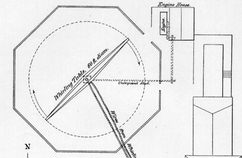
The plan for Langley's whirling table at the
Allegheny Observatory in Pittsburgh, Pennsylvania.
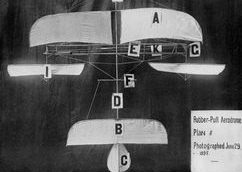
One of Langley's successful rubber band-powered "aerodromes." Note
that the rubber motor is intended to be stretched, not twisted.
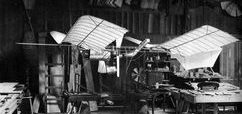
Langley's Aerodrome No. 5 in
the Smithsonian's aeronautics laboratory. This same laboratory
eventually grew to become the National Air and Space Administration
(NASA).
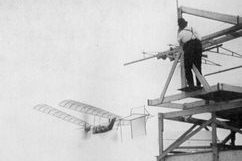
A successful catapult launch of
Aerodrome No. 5.
|
The Lilienthal Glider
The public's attention was focused on Germany on 9 August 1896 when
Otto Lilienthal, by far the most accomplished pilot to date, was caught by a gust of
wind that dashed the pilot to his death. Lilienthal was an inventor, engineer, and
manufacturer who was fascinated with the possibility of manned
flight. He and his younger brother Gustav spent the decades of the
1870s and 1880s collecting information on aeronautics and performing
experiments in aerodynamics. In 1889, Lilienthal published a book,
Der Vogelflug als Grundlage der Fliegekunst (Birdflight as
the Basis of Aviation), that summed up his and his brother's
work. It quickly became a milestone in aeronautics.
In 1890, Lilienthal began to experiment with manned gliders. His
craft had no aerodynamic controls; he navigated his gliders and
maintained equilibrium by
shifting his body weight to alter the balance of the glider in the
air. His first attempts were just barely successful – he achieved
glides of no more than 80 feet (24 meters). But he kept at it,
eventually building and testing 16 gliders, including biplane glider
and a glider that he intended to fly as a powered machine but never
did. With each new aircraft,
he improved the performance of his machines and refined his piloting
skills. Before his death, he had made over 2000 glides, some as long
as 800 feet (244 meters). He also built two facilities for launching
his gliders, a "flight station" at Rhinow Hills and an artificial
hill called Fliegeberg (Flight Hill) near Lichterfelde, a
suburb of Berlin. These were the world's first airfields.
With all this flying going on, Lilienthal's reputation grew. "The
Flying Man" was a common subject for newspaper and magazine articles
all over the world. Great scientists came to visit him, including
Samuel Langley and Octave Chanute. In 1894, he began to manufacture
what he called his "Standard Glider" and sold them to aspiring
pilots in Europe and North America. He was flying this glider on 9
August 1896 when he flew into a thermal, a burst of hot air rising
from the land beneath him. The gust turned up the nose of his
aircraft sharply and Lilienthal kicked forward to bring it down
again. But the glider did not react quickly enough. Lilienthal ran
out of flying speed, the glider stalled, and Lilienthal plunged to
his death from an altitude of 50 feet (15 meters). His dying words
were reported as "Sacrifices must be made." The fatal
accident was news worldwide and many who believed in the possibility
of manned flight were momentarily discouraged.
|
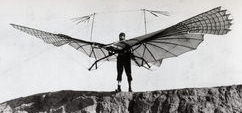
Otto Lilienthal with one of his early gliders.
The flappers at the ends of the wings were intended to propel the
aircraft, but Lilienthal never tested a powered version.

Lilienthal balanced his gliders in the air by kicking his legs. This
shifted his weight and altered the glider's center of gravity.

"Fliegeberg," also called "Flugmonten" (Flight Mountain), was an
artificial hill with a conical hangar on top.
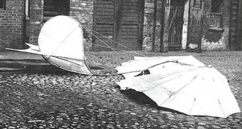
Lilienthal's glider after his fatal crash.
|
The Chanute-Herring Glider
But their hopes were revived again on August 29 when
Octave
Chanute
gathered a band of aeronautical enthusiasts and began testing glider designs at the
Indiana Dunes near Miller, Indiana. Chanute was an accomplished engineer
with an international reputation for building bridges and railroad
terminals. Among his many accomplishments, he had designed the
"Hannibal Bridge," the first bridge across the Missouri River. He
also invented a method of preserving wooden railroad ties and
utility poles with creosote (still in use today) which allowed him
to retire early and pursue his interest in aviation. He
began by collecting everything known about the subject, then
published a series of articles on the prospect of manned flight. In
1894, he compiled these articles into a book, Progress in Flying
Machines, a summary of the science and engineering of
aeronautics up to that time. It became an instant "must-read" for
those interested in manned flight. That same year he started
experimenting with Lilienthal-type gliding machines. A year later,
in 1895, he was designing his own gliders. Chanute walked the line
between chauffeurs and pilots. He worked to find a wing
configuration that would give his aircraft automatic stability, but
he retained Lilienthal's system of weight-shifting for navigation.
Augustus Herring and
William Avery helped Chanute to build and test-fly these
gliders. Chanute also financed
William Paul Butusov, a Russian immigrant, to build a glider of
Butusov's own design. On 22 June 1896, Chanute, his son Charles,
Herring, Avery, Butusov, two dogs, and several reporters took two
gliders – an "improved Lilienthal" and a multiwing machine dubbed
the Katydid – to the sand dunes around Miller. They tested
the Lilienthal first, found it "cranky," and discarded it. The
Katydid was much more docile in the air, but was difficult to
navigate. Nonetheless, after two weeks in the dunes, Chanute felt he
had learned more about aeronautics than he had in the previous ten
years. They were back again on August 29 with two new gliders.
Butusov had completed a large bird-like glider he dubbed the
Albatross. Chanute and Herring had hastily thrown together a
triplane whose superposed wings were trussed in much the same way
Chanute had once trussed bridges. The Albatross did not fare
well; it was wrecked on its first glide. The Chanute-Herring
triplane got off to an auspicious start; it was difficult to
control. Chanute deduced that the problem was the machine had too
much wing and his pilots didn't have enough weight to throw around.
He had the lower wing removed and suddenly everything changed.
Herring and Avery began making stable, controlled flights, staying
aloft for up to ten seconds and covering over 250 feet (76 meters).
For the moment, the Chanute-Herring biplane glider was the most
advanced flying machine in the world.
 What's
in a Truss?
What's
in a Truss?
|
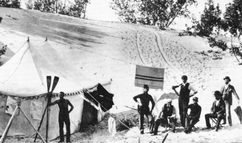
Chanute's camp in the Indiana Dunes..
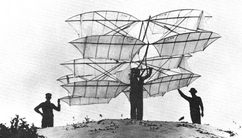
Chanute's Katydid had
multiple wings that could be added, subtracted, or moved to
reconfigure the glider.
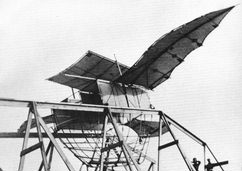
Butusov's Albatross was too
large to be hand-launched. It rolled down a ramp.
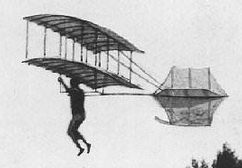
Augustus Herring flying the Chanute-Herring glider as a biplane.
|
|
|
|